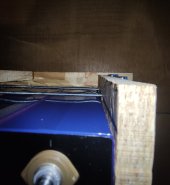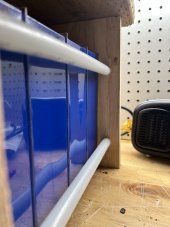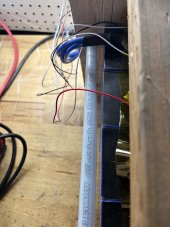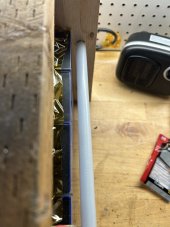Hi All, I'm new here, and am in the process of assembling a house battery pack for daytime use of cheap off-peak EV electricity.
The pack consists of two rows of eight EVE 280Ah 3.2V prismatic LifePO4s, clamped together with six M5 bolts. There are 1mm plastic sheets between each cell, and then the end plates are 1mm plastic sheet, followed by 12mm OSB board, followed by 3mm angle iron, followed by coin washer and nyloc M5 nut.
The spec says to clamp them with 300kg of force.
This was my methodology:
Using this website's calculator.
Two rows = 600kg. 600kg * 9.81ms^2 = 5886N.
Per bolt, /6 = 981N per bolt.
Website, on default settings, gives 5.89Nm per bolt.
To be on the safe side I decided to go with the minimum of what my torque wrench will do; 2.5Nm. In theory, this is going to give under half of the required load; ~100-150Kg, which "should" be alright; still a decent amount of clamping force and better than nothing.
Not spotting any issues while repeated sequence-tightening, and everything seeming okay; I eventually get to 2.5Nm on each bolt and have a really close inspection of everything.
The end cells are slightly deformed ?
The short sides "bulge up" against the end plates. It's not as obvious from the photos (although you can see what's happening in the reflection of the M5 rods in the cell casings to some extend). In real life it's a bit cringier!
There's no visible deformity in the other cells.
Is this deformity to be expected or has it gone wrong; and if so where did my method fail?
Should I reject these cells?
The pack consists of two rows of eight EVE 280Ah 3.2V prismatic LifePO4s, clamped together with six M5 bolts. There are 1mm plastic sheets between each cell, and then the end plates are 1mm plastic sheet, followed by 12mm OSB board, followed by 3mm angle iron, followed by coin washer and nyloc M5 nut.
The spec says to clamp them with 300kg of force.
This was my methodology:
Using this website's calculator.
Two rows = 600kg. 600kg * 9.81ms^2 = 5886N.
Per bolt, /6 = 981N per bolt.
Website, on default settings, gives 5.89Nm per bolt.
To be on the safe side I decided to go with the minimum of what my torque wrench will do; 2.5Nm. In theory, this is going to give under half of the required load; ~100-150Kg, which "should" be alright; still a decent amount of clamping force and better than nothing.
Not spotting any issues while repeated sequence-tightening, and everything seeming okay; I eventually get to 2.5Nm on each bolt and have a really close inspection of everything.
The end cells are slightly deformed ?
The short sides "bulge up" against the end plates. It's not as obvious from the photos (although you can see what's happening in the reflection of the M5 rods in the cell casings to some extend). In real life it's a bit cringier!
There's no visible deformity in the other cells.
Is this deformity to be expected or has it gone wrong; and if so where did my method fail?
Should I reject these cells?











